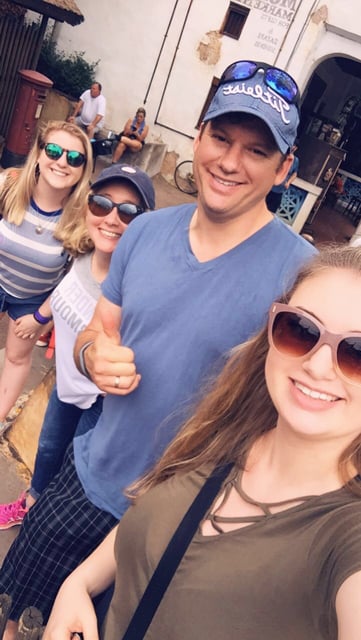On Sunday, May 20, 2018, I was flying down to Florida to attend a work conference to learn and share best practices with the best and brightest in healthcare. It was a beautiful sunny day with light northwest winds and everything was going better than planned. Accompanying me on this trip was my lovely wife, Susan, and two eldest daughters, Brittni and Emily. We were all feeling great and equally excited to be together while spending some quality time with one another in sunny Florida. Everything couldn’t have been going smoother on this trip, as we discussed all the fun things we would be doing together when we arrived in Orlando on the car ride to the airport.
As planned, we arrived two hours early to get through the security check at Albany International Airport, leaving us plenty of time before our 6:45 p.m. Southwest Airlines departure. It was a beautiful May evening with very few clouds in the sky. After arriving at the airport, we had an hour to spare so we grabbed a light dinner and continued to chat, feeling pumped about our trip! This was an especially meaningful trip for our family as my wife just finished her MBA a week prior, and my daughters had successfully finished their junior years at Siena College and Syracuse University, respectively. We are very fortunate to be able to travel together often as a family and this one was slated to be a fun one, as we planned to enjoy some poolside time and even work in half-day trips to the Animal Kingdom and Epcot to celebrate their achievements and my upcoming 44th birthday.
After boarding the aircraft, I sat in window seat 22 and my wife was on my right. My daughters had seats directly across the aisle from us. Then we taxied briefly to the runway to prepare for takeoff. During that moment, I said a little prayer feeling blessed and so thankful for the opportunity to attend this event and be with my loved ones. We all smiled at each other and each one of us busied ourselves with either reading materials or headphones to listen to music.
Then the unthinkable happened, shortly after takeoff, maybe 10 minutes into the flight, we experienced some moderate turbulence. At first glance, the choppy air chatter didn’t seem to bother me much, as I am a seasoned flyer, so I quickly continued to read my book while looking occasionally out the window happily saying goodbye to Albany, New York. While glancing back to my book I vividly remember the sudden feeling of nausea, being diaphoretic, and impending doom flooding my senses. Unfortunately, I knew this feeling all too well, as it has happened two other times in my life for unknown reasons. Before I could utter a single word to warn my wife and the Southwest crewmembers, everything suddenly paused and got extremely quiet and peaceful while a warm soft white light flickered in the distance. The next thing I remember is waking up to frantic voices of my wife and daughter’s crying and yelling, “please help my dad”. In the first few seconds after coming to, I was severely confused and having a hard time focusing. In the immediate moments of my arousal, I recognized the kind face of an older gentleman and younger women hovering over me. Impressively, they managed to lay my 6-foot-4, 240-pound body out between the three seats. I know that wasn’t an easy task! The nice gentleman proceeded to quickly take my blood pressure and pulse while the caring individual sitting directly behind me who identified herself as Carol, an OR nurse, gave me much needed words of encouragement while gently placing the oxygen mask over my mouth and nose.
“David, my name is Henry and I am a doctor, it looked like you might have had a vaso vagal episode or seizure for about a minute and a half. Do you know where you are?” I looked at them puzzled and confused barely able to get a word out. Then it dawned on me what happened, as I tiredly whispered, "I think we are all going to Orlando to see Mickey?" After this episode, the rest of the plane ride seemed like an eternity, as I was feeling extremely tired and dizzy. Although I was lethargic and feeling out of it, I was alert enough to overhear all the commotion and vital signs being verbalized between the gentleman and airline stewardess to provide to the Southwest physician on the plane’s emergency phone line. The dialog continued and my wife gave them my medical history. I heard them say, "44-year-old healthy male with a history of syncope, presenting with seizure-like episode for 1 ½ minutes. The patient is postictal but awake, easily denies chest pain or shortness of breath. Vital signs as follows, BP 110/64 HR 62 O2 sat 95% on 100% O2. The patient is laying down across the seats at 30 degrees and placed on 100% O2. He is groggy but alerts to verbal stimulus and aware of person, place and time." Being in the medical profession myself and having experienced this two other times in the last three years, I was optimistic and praying things would steadily improve.
During the remainder of the flight, things started to become clearer and I started to feel a bit like myself again and even walked later to the bathroom with a volunteer fireman who happened to also be on the plane. “Don’t worry Susan, I got your husband’s back and will catch him if he feels dizzy or falls,” the fireman said. Although I didn’t have an answer as to why this particular event happened, I was anxiously wanting to find out quickly. Approximately a year to the date, I experienced a similar episode while in the bathroom splashing cold water on my face while feeling light headed. Thankfully, I also had my family with me and was able to get immediate medical attention and further diagnostic testing. After a 6-hour local Urgent Care Center visit, the emergency MD did a comprehensive workup. To my surprise, they verified that all my testing including the EKG, cardiac blood work, chest x-ray, and CT scan all came back normal. At this moment, my wife and I knew that we needed to get this investigated further and we continued to advocate to be referred to a cardiologist.
After my visit to see the cardiologist, he educated me on a new loop cardiac monitor from Medtronic. He said, “if this was me, this is the device I would have implanted, especially if you are active.” He continued to educate me that it would be a same day surgery procedure to have the super slim cardiac loop implanted into my left chest wall directly over my heart. “This way,” he said, “if anything happens like this again, our team will be able to capture any potential cardiac events prior to me passing out or feeling faint.” Well, that was over a year since that last episode as they checked in every month saying everything was normal and the monitoring loop was successfully transferring information and nothing looked abnormal. To be honest, I almost forgot I even had the loop implant as I was eating healthy, exercising regularly, and felt in excellent health.
After the plane’s safe arrival, I did decline medical attention but took it easy and even had my family push me in the wheelchair down to baggage claim. That night I ate and slept fine in the hotel room with no issues what so ever. Over the next few days at the conference, I attended a few of the events and avoided any strenuous activities. In hindsight, I probably should have sought out medical care in Orlando but knowing myself and feeling bad that it would cut our trip short I played it down and acted like it wasn’t that big of a deal. I did, however, with my wife and daughter’s persistence, call my primary care doctor and cardiologist, making appointments for both on the day of our flight arrival home.
During the rest of the stay in Orlando, I felt off but did not want to make it apparent to my family that I thought something was probably very wrong with me. After arriving back in New York, I immediately held the scanner/transmitter and sent the transmission over to my cardiologist. My appointment with my primary was that day as well, and he explained that it sounded like a seizure. However, they still needed to see what the cardiac loop had recorded. Around 30 minutes after the appointment, the cardiologist NP called my cell phone, saying, “David, the ECG monitoring team sent me your recorded episode that showed me a 20 second pause in your heart.”
There was a very long and dangerous pause at 7.05 p.m., the exact time of the episode on the plane. I reflected on the event and how lucky I was to be alive. The NP continued to explain that I have a condition known as sick sinus syndrome. I became silent when she said, “Although this condition is rare, it can happen to healthy adults and even children”. According to the Mayo clinic, sick sinus syndrome is a node dysfunction that leads to a series of heart rhythm problems that cause the heart’s natural pacemaker to produce abnormal signals[1]. The heart rhythms of a person with this syndrome can be too fast, too slow, or interrupted by long pauses. Although this syndrome is uncommon, the risk of developing it increases with age. Similarly, many people with this condition eventually need a pacemaker to regulate this rhythm.
I proceeded to explain the plane incident to the NP, and that’s when she said, “David I am highly recommending you get over to the hospital today to get a pacemaker implanted ASAP.” After a long silent pause, I said, “Yes, I know this is the best way for me to prevent this from happening again.” I calmly packed up my things to finish my 10 a.m. team meeting that day and shared the news with my wife and family and they took me to the hospital at 1:30 p.m.
In closing, the 20-second pause of my heartbeat at 36,000 feet gave me another chance to reset things literally. So, on May 26th, one day prior to my 44th birthday, I was admitted to Albany Medical Center’s Electrophysiology surgery unit to receive a 2018 state-of-the-art Medtronic duel monitor pacemaker. Given the short notice, I was amazed and so thankful to have been added to the surgeon’s caseload that day, especially since it was the Friday before Memorial Day weekend! For this, I felt very fortunate and blessed to have this life-saving procedure and device for my birthday present. In the end, my main takeaway from this conference and event is that life is short and not everybody gets a second chance to reset the clock. I am so thankful that this situation turned out well for my family and myself. We can’t thank enough all the caring volunteers on Southwest flight 3759, and the medical professionals who just happened to be sitting near me who “paused for a moment,” to care for a person who needed help.
Finally, it was humbling to witness first-hand the excellent care and compassion from all the nurses, doctors, and ancillary staff as I have a renewed perspective on the importance of having skilled and caring individuals at both 36,000 feet and at the bedside.
Live well,
David

References
1. Mayo Clinic. (2018, February 15) Sick sinus syndrome: Symptoms and Causes. Retrieved from https://www.mayoclinic.org/diseases-conditions/sick-sinus-syndrome/symptoms-causes/syc-20377554

Let Us Know What You Thought about this Post.
Put your Comment Below.